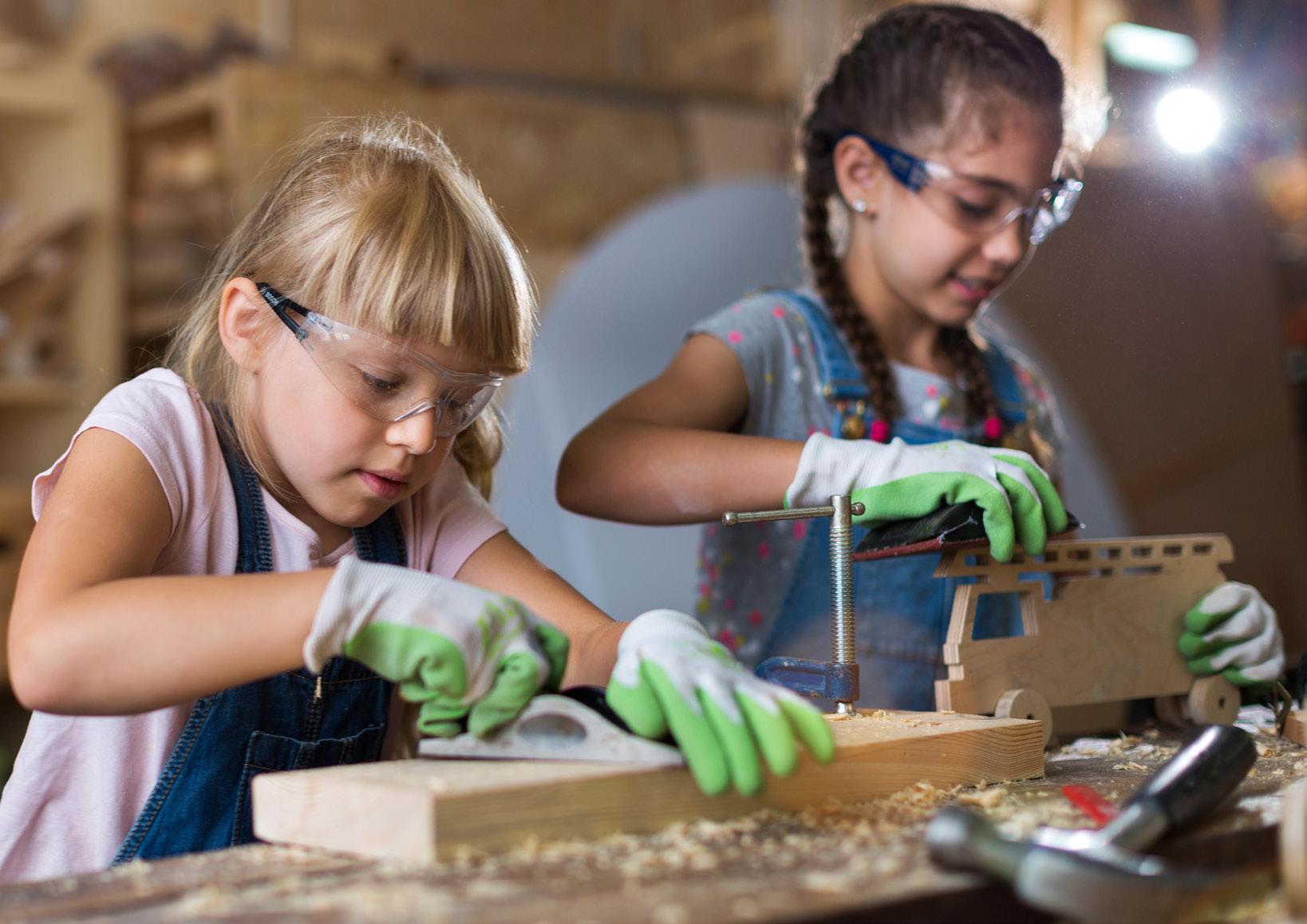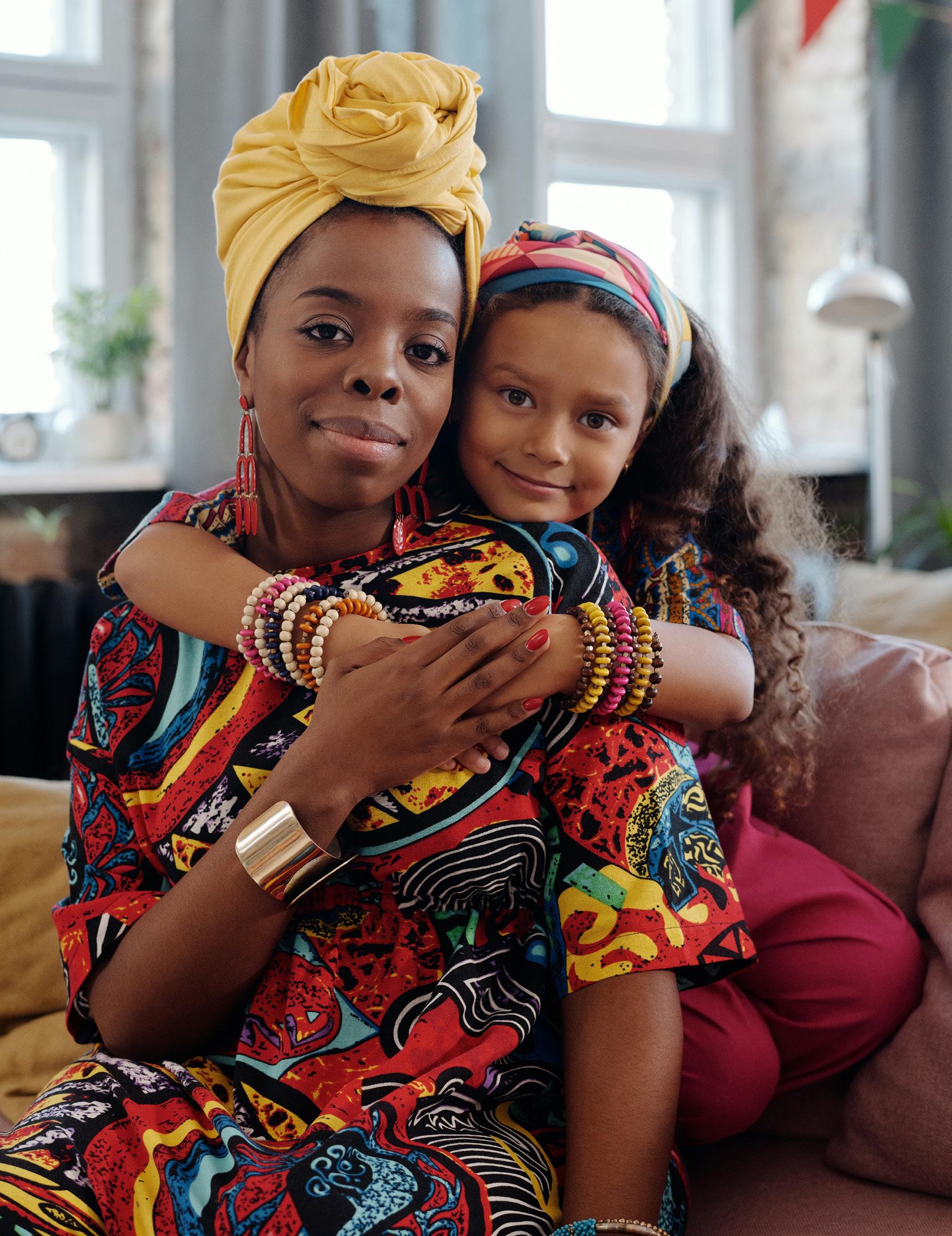
9 minute read
The Wonder of Woodworking
Woodworking
A conversation with Lorna McGrath and Pete Moorhouse
A few months ago, we had special guest, Pete Moorhouse, an expert on woodworking with kids on our weekly Montessori Family Life Webinar broadcast. In this interview with Pete, he shares some of his
insights and ideas from woodworking with young children.

LORNA: What are your thoughts about why children get so enthusiastic about the idea of woodworking?
PETE: Woodworking is actually such a unique activity for young children to do. It’s so different from everything else—they use real tools and authentic materials to make their own constructions. And I think one of the things that really stands out is just how it draws in children’s curiosity. Woodworking captivates them, and you see astonishingly high levels of sustained engagement.
Children become really focused and concentrate on what they’re doing. The most astonishing thing about woodwork is the length of time children stay with this activity. They can span a whole morning or afternoon entirely engaged in their project. We see this across the world. It’s not unique to the United Kingdom. It’s absolutely everywhere, from the United States to Japan to the Middle East. Woodworking, using tools, is a universal language that gives children great enjoyment. And interestingly, in terms of education, this is nothing new. It used to be widespread in education right from the early 1900s, and it was pretty much embraced in schools around the world. LORNA: Why do you think educators and parents shied away from letting children have the experience of using tools?
PETE: What was very much widespread, in recent decades has very much fallen off the agenda. I think is to do with the risk aversion in a litigation culture. Educators were concerned about children getting injured and the possible legal liabilities. I think those worries made a big impact. But I think these days, people are much more willing to embrace this sort of challenge again, which is so positive. The other thing is, I think that culturally, we’ve been very much removed from the “making process” for many years, living in an overly commercialized world. Generally, there seems to be a real resurgence of interest in letting children make and create with their hands again. And I think woodwork’s no
exception to that. This seems particularly true in the United States, where the birth of the “maker space” originated.
“Maker spaces” and labs have spread all over the United States, where adults and teenagers can get together. Now we see a lot of tinkering labs in the high schools, elementary schools, and in early childhood settings. I believe, particularly for children in early childhood, that woodwork is the best way for them to fully engage with the mind-set of STEM-based

I’ll add that I think the real risk to children is that they don’t experience any risk at all. It’s a very important part of child development that adults allow children to encounter risk.
learning. There is another challenge at the moment. We have a new generation of children moving through. I often talk about this new generation of children learning how to swipe before they can walk. And I think this is having a significant impact.
LORNA: So what do you see as the benefits of woodworking to this new generation?
PETE: We need to do our best to nurture children with some really positive influences to counteract the influence that gadgets and devices have on children. The physicality, the movement, and the hands-on experiential learning woodworking provides is a wonderful antidote for this two-dimensional, screen-based existence. It’s wonderful for children to really create something tangible with their hands. Finally, woodworking is really an exceptional activity for developing children’s thinking skills, as children envision and plan out their strategies for creating from wood.
It’s a constant problem-solving process as children go through making and creating with wood. Woodwork is just so rich, in imagining what they want to make and figuring all of those problems that they run into along the way. Creativity, in this context, is just so important. Children are increasing their communication skills with new vocabulary as well as using measurements and angles from math in real-life projects. Creativity has to be about the heart of that learning for it to be meaningful and remembered. Our world needs innovators to come up with solutions in these rapidly changing times, whether it is facing climate change or COVID-19.
LORNA: And might I add that Maria Montessori held hands-on learning as a fundamental principle of her method of education. She said that you cannot give something to the mind that you don’t first give to the hands.
PETE: Absolutely. She talks about didactic material that children can really engage with on a significant level. And, there are so many materials and media that children can use, such as modeling clay. You could use it in so many ways. Wood is quite special because of the way that it draws children in and sustains engagement. I think it’s the excitement of using the tools and being able to master them that helps develop a child’s confidence and self-esteem.
LORNA: One of our participants asks if is it safe for three- and four-year-olds to do woodworking.
PETE: A lot of people are shocked at the thought of three- and four-year-olds using real tools like hammers and saws. We are quite careful in the choice of tools. There are certainly some tools that are much more ergonomically suited to young hands. Actually, children really step up to the responsibility of being given real tools. They actually suddenly take them quite seriously. We’ve found that their behavior with tools is absolutely exemplary. They take great pride from using them.
Occasionally, of course, there’s going to be the bumped thumb. We’re not going to eliminate that, but in 25 years, we have not had a serious accident. Often much worse happens just running across the playground and taking some skin off your knee. The type of injuries that happen while woodworking are actually very low-risk, small-scale things. There are obviously some health and safety measures that we need to put in place to reduce those risks. Teaching children to use tools properly, using safety precautions (like wearing safety glasses) and supervising their activity without doing it for them will help cut the risks. Small, stubby hammers work absolutely perfectly for little hands. Saws that actually cut as you pull them towards you are so much easier for children to use. So a lot of it is about having the right gear, proper lessons, and supervision.
I’ll add that I think the real risk to children is that they don’t experience any risk at all. When we surround them in bubble wrap, and we don’t allow them to make their own decisions and judgments, when they get older they are not going to have that skill set to be able to make a decision. It’s a very important part of child development that adults allow children to encounter risk, obviously within controlled circumstances. We use hand tools, not power tools and very carefully manage those learning opportunities that include the possibility of risk.
LORNA: A dad asks, do you have tool recommendations, types and/or specific tools? Do you have recommendations for teaching safety?
PETE: On my website there’s a free downloadable resource list and photos available of all the different tools. There’s also my book called Learning through Woodwork, which is available from Amazon.
By being given tools to use for building, children are empowered. They feel a sense of responsibility and step up. At first children might be a little bit apprehensive because they may have never used real tools, but very quickly, with the right size and shape tools like the short, stubby hammers or screwdrivers, they gain confidence and skill. It’s actually
what’s happening inside the child that boosts their pride, self-esteem, confidence, and delight in their work.
Other areas of learning, with regard to physical developments, include hand-eye coordination, and fine-motor skills when gently tapping a nail into place. Using and coordinating large-muscle skills comes into play, as well, because every tool has got slightly different physical properties—from the rotation with the screwdriver to two-handed rotation with a hand drill and then posture and body poise needed when sawing.
Woodworking can be a real antidote to continuous use of digital technology. Woodworking can involve literacy, as they do some research during the planning stage of the project. As they plan and envision what the project will be, they can draw it out on paper and later, they can write about what they’ve made. They use mathematical thinking to learn in a very natural way. They figure out what length nails they need to join things together. Quite a few bits of mathematical equipment are introduced in woodworking projects, and it is fantastic how they start using them in different applications. There are definitely a bunch of tape measures, rulers, t-squares, and levels in the woodwork area.
I see woodwork as another way in which children use and express their imaginations. I think it’s important that children are at the center of their learning. Maria Montessori talked about the self-education of the child. So, rather than having predetermined projects for all the children, which strips the creativity out of it and turns it into an exercise in following instructions, allow children to plan and create what they want, using their intrinsic motivation to persevere and solve challenges along the way. It then becomes a delightful mixture of learning, creativity, problem solving, and fun!
NOTE: Pete had lots more to say in our broadcast. You can watch the entire session on montessori.org in the Montessori Family Alliance Resource Center, where over 300 webinars, hundreds of articles from Tomorrow’s Child magazine, and many audible recordings are archived when you subscribe to the Montessori Family Alliance for only $4.99USD per month. Become a member at https://bit.ly/3c71eVa.
Pete Moorhouse is an early years creative consultant and artist educator. He is an honorary research fellow at the Graduate School of Education, University of Bristol researching creative and critical thinking in Early Years, regularly presenting research at international conferences. Pete is an associate trainer for Early Education and deliverers training both nationally and overseas. He is the UK’s leading authority on woodwork in Early Years education and has written several books and journal articles, including Learning through Woodwork (Routledge) and Outdoor Learning. He is currently working his latest book, Creativity in Practice: Nurturing creative and critical thinking in early childhood education.











